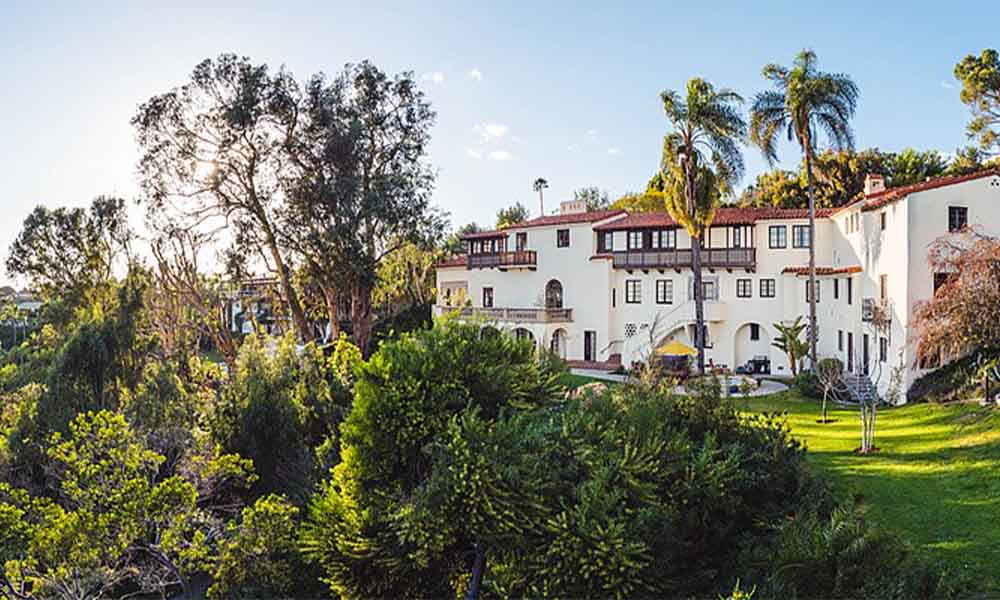
PACIFIC PALISADES, CA—For nearly a century, Villa Aurora has stood on a windswept hillside in this coastal neighborhood of Los Angeles. The mansion’s white stucco walls and Spanish Colonial Revival design match any number of similarly styled homes dotting L.A.’s rugged bluffs. Yet for those who know its story, Villa Aurora is more—a record of German-Jewish exile, a refuge built by intellectuals fleeing Nazi Europe, and now a stark reminder of how fragile cultural memory can be.
Villa Aurora was built in 1928 through a partnership between The Los Angeles Times and private investors, intended as a model home to attract affluent homebuyers to the area. Lead investor Arthur Weber spared no expense, importing Spanish beams and Italian fountains, installing a pipe organ to accompany silent movie screenings, as well as state-of-the-art appliances and an electric garage door. The Great Depression sunk the project; Weber and his family lived there as renters until 1939, after which the property sat idle and fell into disrepair.
The blaze forced emergency evacuations across the neighborhood and threatened to reduce Villa Aurora to ash.
In 1943, Lion Feuchtwanger, known for novels such as Jew Süss (1925) and Success (1930), and his wife Marta bought the villa to live in and soon transformed it into a communal space that offered safe haven for those fleeing Nazi persecution, as they had, as well as creative inspiration to German-speaking exiles in Southern California. They hosted a wide range of artists and thinkers at Villa Aurora. At one time, its rooms rang with the voices of Bertolt Brecht, Thomas Mann and even Charlie Chaplin. Such gatherings gave rise to the nickname “Weimar under the Palms.”
“It was a place of conversation, creative brainstorming and communal support,” says Claudia Gordon, director of Villa Aurora, as well as the nearby Thomas Mann House.
Thomas Blubacher, an author who has long chronicled the lives of German exiles in Pacific Palisades and was writer-in-residence at Villa Aurora in 2002, recalls that when Marta Feuchtwanger died in 1987, she had been the last prominent personality of Weimar under the Palms. (Lion died in 1958 from complications arising from stomach cancer.) “Her passing symbolically closed that chapter.” But in 1995, a partnership between German and American cultural organizations stepped in to convert the villa into an international artists’ residence and cultural hub. They restored many original features and revived fellowship programs that went on to host up to 20 artists a year—writers, filmmakers, composers and visual artists who work to continue the legacy of free expression and resilience.
On January 7, 2025, a fast-moving wildfire tore through the canyons of Pacific Palisades. The blaze forced emergency evacuations across the neighborhood and threatened to reduce Villa Aurora to ash. Within hours, flames raced over dry chaparral and leapt from ridge to ridge. Gordon, two housekeepers and a handyman, as well as Taylor Dwyer, curator of the Feuchtwanger Memorial Library at USC who was working on a project at the villa, rushed to secure the building and protect its priceless collection of rare books, artworks and other objects that reflect the spirit of Weimar Germany transplanted to California. “Within half an hour, it was clear we had no choice but to evacuate. We dropped everything and left,” Gordon recalls, her matter-of-fact tone belying the chaos of the morning.
“We took about 11 pieces—paintings, sculptures and that Purim Esther scroll from the 16th or 17th century,” says Dwyer. “The big furniture and thousands of books had to stay.”

Villa Aurora’s gardens were scorched and the slopes behind the house turned black, but the structure itself remained standing. Credit: VATMH/Claudia Gordon
Local news reported widespread destruction as flames engulfed nearby homes along Pacific Coast Highway. Fire crews labored in 12-hour shifts through the night, battling gusts and erratic fire lines. The villa’s gardens were scorched and the slopes behind the house turned black, but the structure itself remained standing—a small mercy amid significant loss. That narrow escape has prompted renewed consideration—not only about the villa’s physical vulnerability but about its role as a keeper of cultural lineage. In a moment, decades of carefully preserved diaspora past nearly vanished. “If the fire had destroyed the house, that would have been a major cultural loss,” Dwyer concludes.
The struggles of exile are not just historical—they speak to ongoing issues of displacement and the search for belonging.
“Villa Aurora is a reminder of both exile history and the power of creative expression,” says Blubacher, whose 2023 book, Weimar Under the Palms: Pacific Palisades, German Exiles and the Invention of Hollywood, is being translated to English (by Elisabeth Lauffer) and is set for publication this October. “Today, those values seem more vulnerable than ever.”
This notion is echoed by Jeffrey Blutinger, Barbara and Ray Alpert Endowed Chair in Jewish Studies at California State University, Long Beach, in discussing Lion Feuchtwanger’s novels. “When you read works like The Oppermanns or the Josephus Trilogy, you see that the struggles of exile are not just historical—they speak to ongoing issues of displacement and the search for belonging,” Blutinger observes. “He captures the frustration of never quite feeling safe, even when you’ve made it to a new country.”
The Feuchtwangers faced other hurdles common to so many émigrés trying to make a new home for themselves. Lion Feuchtwanger’s quest for U.S. citizenship was delayed by his controversial 1937 trip to the Soviet Union and his subsequent defense of Stalin’s regime. “The letter granting him citizenship arrived just after he died,” Claudia Gordon recalls. Marta, too, endured a lengthy process before finally obtaining citizenship.
For many immigrants, the exile legacy is not abstract. It is lived and felt. “There’s something about the tangible nature of a house like Villa Aurora,” says Gordon. “It’s one thing to know that exiles came here. It’s another to walk in the same rooms, see the same ocean views and understand that this was a real haven when so much else was burning…You could walk through history in that house.”
Over the decades, Villa Aurora has weathered both natural disasters and the tides of political change. The 1961 Bel Air Fire tore through the Bel Air and Brentwood neighborhoods, destroying over 500 homes and came dangerously close to the Palisades. Although it didn’t reach Villa Aurora, it rattled Marta, and she refused to leave until she had rescued as many of Lion’s books as she could. The memory hung over the villa like a warning bell, which rang loud and clear once again this past January.
After the Palisades fire was declared 100 percent contained after burning for 24 days, insurance adjusters, structural engineers and environmental experts converged on the areas to assess the damage. Early findings showed that while the main structure of Villa Aurora was sound, significant remediation was needed. “The roof, which had already been tested by the 1961 fire, withstood the flames again, though some tiles are cracked,” explains Gordon. “We’ll need months of environmental testing and cleanup before we can reopen.” Cultural programs were canceled—such as the annual pre-Oscar reception for German filmmakers—and others postponed. Gordon says they’ll reopen as soon as it’s safe to do so. “We want to rebuild the garden, restore the terraces and reopen the residency quarters,” she says. “The house was always meant to be shared.”
Villa Aurora’s ordeal is a clear reminder that cultural memory is fragile. “In a place like L.A., where wildfires are an all-too-real threat, preserving historical properties is never just theoretical,” says Dwyer. “Without sustained investment and public attention, structures like Villa Aurora could vanish in a single day.”
Scarred but unbowed, the villa stands as a symbol of resilience—a space for conversation, artistic creation and collective remembrance. In a city known for reinvention, Villa Aurora remains a quiet beacon on the Palisades—a place where history and hope meet.
Opening image credit: Mirkomlux (CC BY-SA 4.0)



One thought on “A House in Exile: Fire, Memory and the Enduring Spirit of Villa Aurora”
Wow! Great reporting! I had never heard of this stunning place!